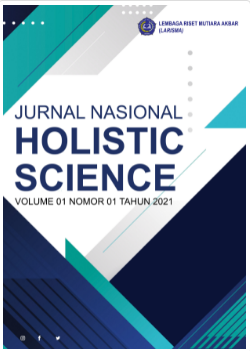Analysis of Student Mathematics Learning Results Using the Problem Based Learning Model
Main Article Content
Abstract
Student learning outcomes are a measure of student success in the learning process in class. This research aims to analyze student learning outcomes in class VII-5 of SMP Negeri 5 Kisaran in mathematics subjects. The type of research carried out was qualitative with a qualitative descriptive method. The research subjects were students in class VII-5 of SMP Negeri 5 Kisaran with a total of 32 people. The analysis technique used in this research is a qualitative descriptive data analysis technique including data reduction, data display, and verification. The results of this research show that the learning outcomes of students with low criteria were 2 students, medium as many as 17 students, high as many as 12 students, and very high as many as 1 student and the average score obtained by students in mathematics learning activities was 20.88 with a percentage 84%, which means that the mathematics learning carried out by students in class VII-5 at SMP Negeri 5 Kisaran is in the good category.
Article Details

This work is licensed under a Creative Commons Attribution-ShareAlike 4.0 International License.
References
Abdul, R. (2018). Implikasi Landasan-Landasan Pendidikan the Implication of Educational Foundations.
Mailili, W. H (2018). Deskripsi Hasil Belajar Matematika Siswa Gaya Kognitif Field Independent dan Field Dependent. ANARGYA: Jurnal Ilmiah Pendidikan Matematika, 1(1), 1–7. https://doi.org/10.24176/anargya.v1i1.2371
Nuraini, N., Fitriani, F., & Fadhilah, R. (2018). Hubungan Antara Aktivitas Belajar Siswa Dan Hasil Belajar Pada Mata Pelajaran Kimia Kelas X Sma Negeri 5 Pontianak. AR-RAZI Jurnal Ilmiah, 6(1). https://doi.org/10.29406/arz.v6i1.939
Jaul, J., Tasni, N., & Iman, N. (2022). ARITMATIKA?: Jurnal Inovasi Pendidikan Matematika STKIP YPUP Makassar MODEL PEMBELAJARAN KOOPERATIF TIPE STUDENT FACILITATOR AND EXPLAINING ( SFAE ) PADA SISWA KELAS VII Learning Model Type Student Facilitator And Explaining ( Sfae ) for Class VII Student. 03, 51–56.
Paba, N. G., Wahyuningsi, W., Prasetyo, E., & Rusdin, M. E. (2020). Analisis Hasil Belajar Matematika Siswa Di SMK Negeri 1 Maumere. AlphaMath?: Journal of Mathematics Education, 6(2), 108. https://doi.org/10.30595/alphamath.v6i2.7745
Permatasari, K. G. (2021). Problematika pembelajaran matematika di sekolah dasar/ madrasah ibtidaiyah. Jurnal Ilmiah Pedagogy, 17(1), 68–84. http://www.jurnal.staimuhblora.ac.id/index.php/pedagogy/article/view/96
Primayanti, Putu; Suarjana, Made; Astawan, G. (2018). gautama,+5.+Putu+Era+Primayanti+86-95. 1(2), 86–95.
Retnoningsih, E. (2020). Model Pembelajaran Metode Driil Dalam. 1–14.
Siagian, M. D. (2016). Kemampuan koneksi matematik dalam pembelajaran matematika. MES: Journal of Matematics Education and Science2, 2(1), 58–67.
Sugiyono. (2015). Metode Penelitian Tindakan Komprehensif. Alfabeta.
Sukmawati, R. (2021). Penerapan Model Pembelajaran Problem Based Learning untuk Meningkatkan Hasil Belajar Matematika Kelas II SDN Wonorejo 01. Glosains: Jurnal Sains Global Indonesia, 2(2), 49–59. https://doi.org/10.36418/glosains.v2i2.21
Sutama, S., & Anggitasari, B. (2019). Gaya dan Hasil Belajar Matematika pada Siswa SMK. Manajemen Pendidikan, 13(2), 52–61. https://doi.org/10.23917/jmp.v13i2.6396
Tanujaya, C. (2017). Perancangan Standart Operational Procedure Produksi Pada Perusahaan Coffeein. Jurnal Manajemen dan Start-Up Bisnis, 2(1), 90–95.
Wahyuddin, W., & Yusuf, I. W. (2020). Efektivitas Pembelajaran Matematika Melalui Penerapan Model Kooperatif Tipe Student Facilitator and Explaining. JPMI (Jurnal Pendidikan Matematika Indonesia), 5(1), 16. https://doi.org/10.26737/jpmi.v5i1.1369
Wasida, M. R., & Hartono, H. (2018). Analisis kesulitan menyelesaikan soal model ujian nasional matematika dan self-efficacy siswa SMA. Jurnal Riset Pendidikan Matematika, 5(1), 82–95. https://doi.org/10.21831/jrpm.v5i1.10060

